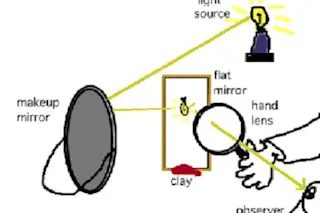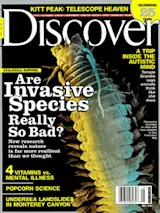Unlike the summit of most other mountains, the one on Kitt Peak ]supports a community of scientists. They are not alpine biologists, but astronomers, a mountaintop community of sky-watchers, whose tools are an assortment of telescopes. Taking advantage of the clear and unpolluted atmosphere, these scientists exploit an arsenal of telescopes to explore the universe.
Reflecting on a model
Many of the telescopes located atop of Kitt Peak use reflecting surfaces to collect light and magnify observed images. In this activity, you’ll model this process. Using a simple makeup mirror, flat mirror, and a hand lens, you’ll observe the basic operation of a reflecting telescope.
Materials: Makeup mirror Flat mirror Clay Hand lens Bright light source (lamp)
CAUTION: Never use this telescope model or other types of viewing tools to look at the sun or other very bright objects.
Steps: 1. Position a makeup mirror on you desktop. Aim the ...















